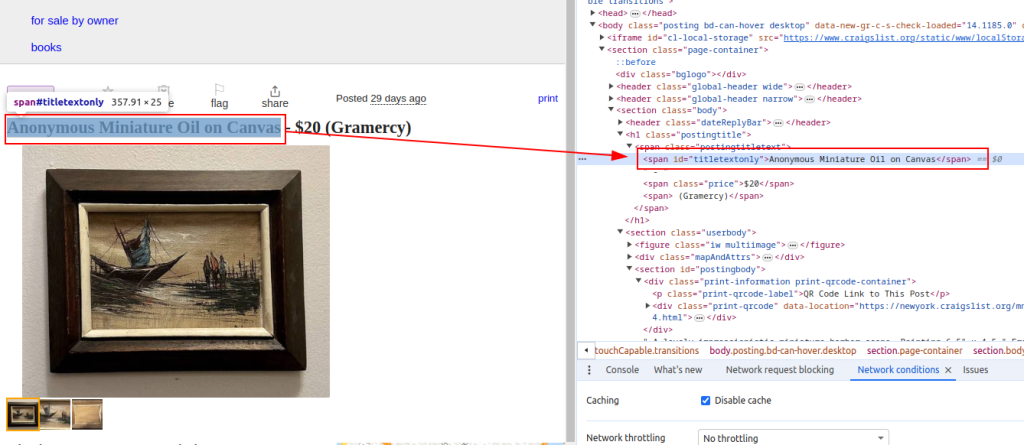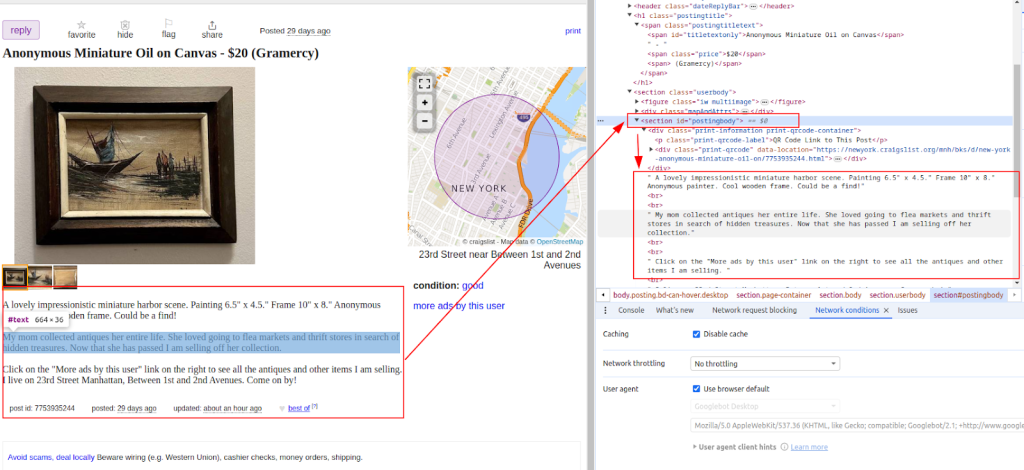
 zh
zh  English
English  Español
Español  Tiếng Việt
Tiếng Việt  Deutsch
Deutsch  Українська
Українська  Português
Português  Français
Français  भारतीय
भारतीय  Türkçe
Türkçe  한국인
한국인  Italiano
Italiano  Gaeilge
Gaeilge  اردو
اردو  Indonesia
Indonesia  Polski
Polski 在数字时代,像 Craigslist 这样的广告平台仍然具有现实意义。收集器有助于自动从广告中提取信息,尤其是直接从网站上获取数据。多亏了 BeautifulSoup 和 Requests 等灵活而强大的库,我们才能高效地完成数据收集工作。本教程主要介绍使用 python 进行 Craigslist scraping,重点介绍 BeautifulSoup、Requests 和代理轮换以避免僵尸检测。
现在,我们将逐步介绍如何搜索 Craigslist。
现在,我们将从向特定网页发送 HTTP 请求、分割所需页面、收集所需数据并以预定格式保存数据开始,详细介绍 Craigslist 的网络搜刮步骤。
必须下载并安装以下软件包:
pip install beautifulsoup4
pip install requests
要从网页中抓取数据,首先需要向要抓取的 URL 发送 HTTP 请求。使用请求库,您可以发送 GET 请求来获取 HTML 内容,然后对其进行处理,提取所需的信息。
import requests
# 要搜索的 Craigslist URL 列表
urls = [
"link",
"link"
]
for url in urls:
# 向 URL 发送 GET 请求
response = requests.get(url)
# 检查请求是否成功(状态代码 200)
if response.status_code == 200:
# 从响应中提取 HTML 内容
html_content = response.text
else:
# 如果请求失败,则打印带有状态代码的错误信息
print(f"Failed to retrieve {url}. Status code: {response.status_code}")
有了 BeautifulSoup,你就可以通过 HTML 从 Craigslist 挑选出你需要的部分。它能让你找到标签、获取文本,并抓取链接或价格等内容。这是一种从凌乱的网页中提取有用信息的简单方法。
from bs4 import BeautifulSoup
# 遍历列表中的每个 URL
for url in urls:
# 向 URL 发送 GET 请求
response = requests.get(url)
# 检查请求是否成功(状态代码 200)
if response.status_code == 200:
# 从响应中提取 HTML 内容
html_content = response.text
# 使用 BeautifulSoup 解析 HTML 内容
soup = BeautifulSoup(html_content, 'html.parser')
else:
# 如果请求失败,则打印带有状态代码的错误信息
print(f"Failed to retrieve {url}. Status code: {response.status_code}")
获取 HTML 内容后,下一步是使用 BeautifulSoup 库进行解析。我们使用函数来执行 Craigslist 数据抓取,例如物品标题和价格等列表。这就好比有了一个工具,可以帮助你从凌乱的代码中快速高效地筛选出有用的部分。
from bs4 import BeautifulSoup
# 遍历列表中的每个 URL
for url in urls:
# 向 URL 发送 GET 请求
response = requests.get(url)
# 检查请求是否成功(状态代码 200)
if response.status_code == 200:
# 从响应中提取 HTML 内容
html_content = response.text
# 使用 BeautifulSoup 解析 HTML 内容
soup = BeautifulSoup(html_content, 'html.parser')
# 提取特定数据点
# 查找列表标题
title = soup.find('span', id='titletextonly').text.strip()
# 查找挂牌价格
price = soup.find('span', class_='price').text.strip()
# 查找列表描述(可能包含多个段落)
description = soup.find('section', id='postingbody').find_all(text=True, recursive=False)
# 打印提取的数据(用于演示)
print(f"Title: {title}")
print(f"Price: {price}")
print(f"Description: {description}")
else:
# 如果请求失败,则打印带有状态代码的错误信息
print(f"Failed to retrieve {url}. Status code: {response.status_code}")
标题

价格

说明

提取 Craigslist 数据后,确保将其存储为 CSV 格式,以方便日后使用或分析,并与其他应用程序互通。
import csv
# 定义 CSV 文件路径和字段名称
csv_file = 'craigslist_data.csv'
fieldnames = ['Title', 'Price', 'Description']
# 将数据写入 CSV 文件
try:
# 以 UTF-8 编码的写模式打开 CSV 文件
with open(csv_file, mode='w', newline='', encoding='utf-8') as file:
# 用指定的字段名创建 CSV DictWriter 对象
writer = csv.DictWriter(file, fieldnames=fieldnames)
# 在 CSV 文件中写入标题行
writer.writeheader()
# 迭代搜索数据列表中的每个项目
for item in scraped_data:
# 将每个项目作为一行写入 CSV 文件
writer.writerow(item)
# 将数据写入 CSV 文件后打印成功信息
print(f"Data saved to {csv_file}")
except IOError:
# 如果在写入 CSV 文件时出现 IOError,则打印错误信息
print(f"Error occurred while writing data to {csv_file}")
如果你想自动收集 Craigslist 网站上的列表,最简单的方法之一就是通过库使用非官方 API。它可以让你查询网站,按类别、城市、价格、关键词等过滤结果。
首先安装程序库:
pip install python-craigslist
下面是一个搜索纽约公寓出租的简单示例:
from craigslist import CraigslistHousing
cl_h = CraigslistHousing(site='newyork', category='apa', filters={'max_price': 2000})
for result in cl_h.get_results(limit=10):
print(result['name'], result['price'], result['url'])
此代码可从纽约市公寓/住房出租部分获取前 10 条价格低于 2000 美元的房源信息。
该库还支持工作、汽车、待售物品等类别,以及各种过滤器。它是快速构建基于 Python 的工具(如机器人、列表跟踪器或市场分析)的绝佳工具。
在网络搜刮(尤其是 Craigslist)时,可能会面临一些额外的挑战。它采用 IP 拦截和验证码挑战来防止刮削尝试。要避免这些问题,可以在轮换用户代理的同时实施代理。
使用代理:
使用代理和轮换用户代理是一种聪明的方法,可以在不被发现的情况下继续进行刮擦。
proxies = {
'http': 'http://your_proxy_ip:your_proxy_port',
'https': 'https://your_proxy_ip:your_proxy_port'
}
response = requests.get(url, proxies=proxies)
用户代理轮换是指更改每次请求时刮擦程序发送的浏览器标识。如果你总是使用同一个用户代理,看起来就很可疑。在不同的用户代理之间切换,会让你的刮擦程序看起来更像正常用户,从而有助于避免拦截:
import random
user_agents = [
'Mozilla/5.0 (Windows NT 10.0; Win64; x64) AppleWebKit/537.36 (KHTML, like Gecko) Chrome/91.0.4472.124 Safari/537.36',
'Mozilla/5.0 (Windows NT 10.0; Win64; x64) AppleWebKit/537.36 (KHTML, like Gecko) Chrome/91.0.4472.124 Safari/537.36',
# 根据需要添加更多用户代理
]
headers = {
'User-Agent': random.choice(user_agents)
}
response = requests.get(url, headers=headers)
整合本教程中讨论的所有模块,就能开发出一个功能齐全的 Python Craigslist scraper。该程序可以提取、解析和浏览大量 URL,并检索所需的数据。
import requests
import urllib3
from bs4 import BeautifulSoup
import csv
import random
import ssl
ssl._create_default_https_context = ssl._create_stdlib_context
urllib3.disable_warnings()
# 要搜索的 Craigslist URL 列表
urls = [
"link",
"link"
]
# 用户代理和代理
user_agents = [
'Mozilla/5.0 (Windows NT 10.0; Win64; x64) AppleWebKit/537.36 (KHTML, like Gecko) Chrome/91.0.4472.124 Safari/537.36',
'Mozilla/5.0 (Windows NT 10.0; Win64; x64) AppleWebKit/537.36 (KHTML, like Gecko) Chrome/91.0.4472.124 Safari/537.36',
]
proxies = [
{'http': 'http://your_proxy_ip1:your_proxy_port1', 'https': 'https://your_proxy_ip1:your_proxy_port1'},
{'http': 'http://your_proxy_ip2:your_proxy_port2', 'https': 'https://your_proxy_ip2:your_proxy_port2'},
]
# 用于存储刮擦数据的列表
scraped_data = []
# 循环浏览列表中的每个 URL
for url in urls:
# 每次请求时轮流使用用户代理,以避免被检测到
headers = {
'User-Agent': random.choice(user_agents)
}
# 为每个请求使用不同的代理,以避免 IP 屏蔽
proxy = random.choice(proxies)
try:
# 向 Craigslist URL 发送带标头和代理的 GET 请求
response = requests.get(url, headers=headers, proxies=proxy, timeout=30, verify=False)
# 检查请求是否成功(状态代码 200)
if response.status_code == 200:
# 解析响应的 HTML 内容
html_content = response.text
soup = BeautifulSoup(html_content, 'html.parser')
# 从解析的 HTML 中提取数据
title = soup.find('span', id='titletextonly').text.strip()
price = soup.find('span', class_='price').text.strip()
description = soup.find('section', id='postingbody').get_text(strip=True, separator='\n') # 提取说明
# 以字典形式在列表中添加刮擦数据
scraped_data.append({'Title': title, 'Price': price, 'Description': description})
print(f"Data scraped for {url}")
else:
# 如果请求失败,则打印错误信息
print(f"Failed to retrieve {url}. Status code: {response.status_code}")
except Exception as e:
# 如果刮擦过程中出现错误,则打印异常信息
print(f"Exception occurred while scraping {url}: {str(e)}")
# 设置 CSV 文件以存储刮擦数据
csv_file = 'craigslist_data.csv'
fieldnames = ['Title', 'Price', 'Description']
# 将搜索到的数据写入 CSV 文件
try:
with open(csv_file, mode='w', newline='', encoding='utf-8') as file:
writer = csv.DictWriter(file, fieldnames=fieldnames)
# 在 CSV 文件中写入页眉行
writer.writeheader()
# 遍历 scraped_data 列表,并将每个项目写入 CSV 文件
for item in scraped_data:
writer.writerow(item)
# 如果数据保存成功,则打印成功信息
print(f"Data saved to {csv_file}")
except IOError:
# 如果在写入 CSV 文件时出现 IOError,则打印错误信息
print(f"Error occurred while writing data to {csv_file}")
既然你已经了解了网络搜刮的工作原理,就不难理解为什么它如此方便--无论你是在分析市场还是在寻找线索。网站上有大量有价值的信息,而 BeautifulSoup 和 Requests 等工具可以让提取数据变得非常简单。本指南还介绍了一些重要的技巧,如处理动态内容和使用旋转代理以保持低调。如果使用得当,使用 Python 进行刮擦确实可以帮助企业和人们在各个领域做出更明智的决策。
评论: 0